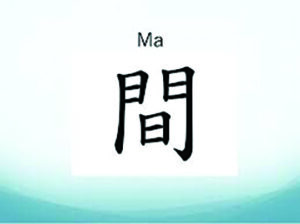To see what doesn’t exist visually – the subtle art of deep perception that borders between the conscious and the subconscious – grants you the freedom to walk into spaces where the geometry and physics of things belie human scope. There are moments of intervals and spaces we meet and encounter daily. The gap between musical notes, the space in a room or corridor, the link broken between trains of thought. That exact moment when the ball stops. That silent beat before the punchline of a perfectly told joke…
All this is a kind of nothingness of empty space and vastness. A moment pregnant with history and possibilities. It’s only there for the grasping if you allow it. It’s bare and barren without a fertile thought without the richness of purpose. But in being that, it encompasses all that is primal and instinctive, waiting to roll out into the world and greet the chaos it could only encounter.
There is a concept in Japanese culture that’s not easily translated to the Western mind, pronounced ‘Ma’ – the written character combines the character for gate with the character for sun. The idea that empty space of the open gate yields light. It literally translates as space or interval. It roughly speaks of the idea of the fullness of the emptiness between. The fullness of blank spaces, and empty thoughts. The quiet presence always speaks the loudest.
The difference between ‘Ma’ and the western concept of space is deep rooted in our respective cultures. In the western mind, space or emptiness is considered universal and homogenous because it is simply absence-of-matter. A space between trees is a quantity of emptiness from the whole of the emptiness. We perceive things in space, as if immersed in a huge giant container. The Japanese view it differently. Ma is not at all like that. Ma is but the specific space between things. It takes form and character from all those things around it. It is part of the whole experience of the moment’s quietness of the entire scene’s wholeness, all contained within it. It does not shy away or deny the entirety of that space, feel, adventure and experience.
The space between flowers, the arrangement of leaves on a tree all apportion space into pleasing shapes and vice versa. There is always something in nothing. Silence can speak louder than words. The joy of Nothing is the space it fills between clutter and pandemonium. The joy of silence is in its very lack of noise. The belief that nothing comes from nothing is a downright lie. For things are created in the nothingness of space and time. Like black holes in space, we can term them blank holes of nothing that grip our beings in constricting vices of thought and penetration, forcing the gastric juices of creativity and creation into churning masses of legit existence.
Ask a philosopher w here emanated his thought, ask a scientist where originated his premise. Chances are they were prompted from nothing into something and then skipping along, wonderous ideas and philosophies were constructed. If we pause for a while and deconstruct this silly notion that nothing means the lack of, there are and could be endless probabilities and possibilities springing and sprouting from the nothingness of things.
here emanated his thought, ask a scientist where originated his premise. Chances are they were prompted from nothing into something and then skipping along, wonderous ideas and philosophies were constructed. If we pause for a while and deconstruct this silly notion that nothing means the lack of, there are and could be endless probabilities and possibilities springing and sprouting from the nothingness of things.
Nothing can be a poem floating around somewhere. Nothing could be the ink that spills on blank pages. And Nothing could be the voices in your head when all is silent outside. Nothing is truly the space of fantastical possibilities floating between coherent thought and endless words. Nothing is the day before dawn. The night following on the footsteps of twilight. Pure nothingness does not contain anything, it is absolute, no light, air, dust or form. So how can we experience it? Our senses cannot tangibly hold to this thought of nothingness but we can conceive it with our minds. The type of nothing that existed long before our universe even existed or sprang into being. Most people shy away from the nothingness of things, always thinking that it may lead them to dark bleak places of absolute voids. However, when one looks at it a little closer, nothingness appears everywhere.
Over time there have been questions and there have been answers to this concept of ‘Pure Nothing’. Philosophers have pondered, poets have eulogised, scientists have debated. But ‘Nothing’ in its absolute form, spoken in a universal language, with people and ideologies everywhere, is as difficult a concept of comprehension as any.
Many sharp poets at this point are perhaps working right now to explain its mysteries. I knew going into this mystical panorama of nothingness that it was a vast, overwhelming and expansive concept. The literature of expression can only explain it best as an otherwise inaccessible essence of reality, non-existent with interspersed closeness with matter, being, thought and essence. In the end, we have to remember not the ‘loud presence of something but the silent absence of nothing’.
- Women Are Simply Awesome! - 8 March2025
- Romantic Love – Win Some, Lose Some! - 8 February2025
- Right Over Wrong Every Single Time! - 25 January2025
